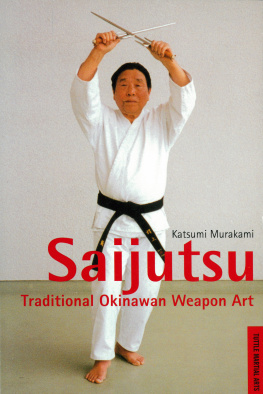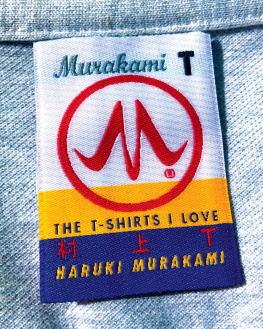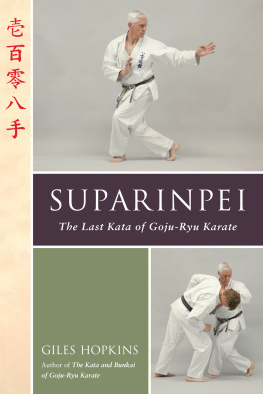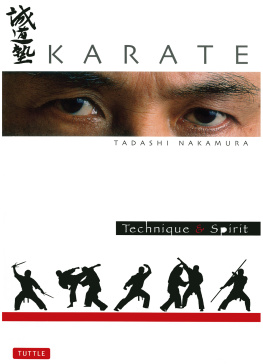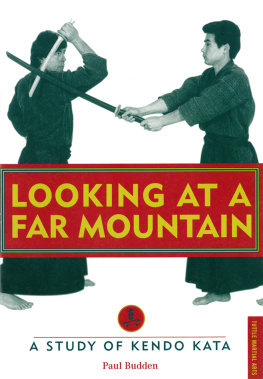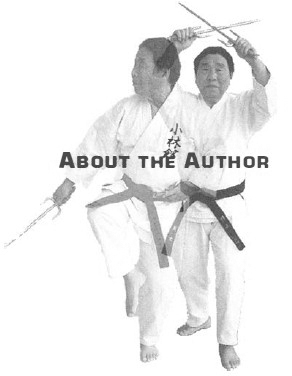
Murakami Katsumi was born in Fukuoka Prefecture in 1927. He has trained in jujutsu, kenpo, karatedo, Ryukyu Kobudo, and Chinese quanfa. In 1973, he was invited by the Goju-kai Karatedo Australia Branch to give an introduction to Karatedo and Ryukyu Kobudo. He is licensed in Shorinryu karatedo as Hanshi 9-dan, and holds a Shihan license in Toonryu karatedo, Shihan in Ryukyu Kobudo, and an instructors license in Chinese Quanfa ( Taijiquan, Xingyiquan, and Baguazhang). Through diligent, hard training in karate and kenpo, he aims at harmonious, balanced training for both the body and the spirit. He advocates martial arts training to unify the mind and body. As the head of the Shorinkan Dojo, he is engaged in teaching and promoting the martial arts. Other books by the author in Japanese include Karatedo to Ryukyu Kobudo (Karatedo and Ancient Ryukyu Martial Arts), Ryukyu Bojutsu, (Staff Fighting of Ryukyu), Karate no Kokoro to Waza (The Spirit and Technique of Karate), and Ryukyu Bojutsu no Higi (Secret Techniques of Ryukyu Bojutsu). He resides in Tagawa City, Fukuoka.

Enbusen (floor design or performance pattern):


Hold both sai in the left hand, facing east, standing in musubi-dachi stance.

Bow.

Hold the pair of sai with one in each hand. Cross the sai in front of the chest. Follow by moving both sai downward to the sides of the body, while moving the left and the right foot into hachiji-dachi stance. Assume the hiraki-yoi position (hinged ready stance).

Slide-step (the same footwork as in karates oi-tsuki, lunge punch) to the east with the left foot, and perform, a left reverse sai middle-level thrust.

In the same position, follow with a right reverse sai middle-level thrust.

Slide-step to the east with the right foot and right reverse sai middle-level thrust.

In the same position, follow with a left reverse sai middle-level thrust.

Step to the east with the left foot, and perform, a left reverse sai middle-level thrust.

In the same position, follow with a right reverse sai middle-level thrust.

Move the left foot to twist the body to face the opposite direction (west). Stand on the left leg with the right leg raised and execute a right sai downward block.

Drop the right leg. Bring the handle of the right sai to the waist. With the left sai, perform, an upper strike.

Stand on the right leg with the left leg raised and execute a left sai downward block.

Drop the left leg and perform a right upper sai strike.

Change to a left cat stance and perform a left reverse sai inside middle block. Bring the right sai in the reverse position to the waist.

Move the right foot forward. Perform a right reverse sai middle-level thrust.

Change to a right cat stance. Perform a right reverse sai inside middle block.

Step forward with the left leg. Perform a left reverse sai middle-level thrust.

Change to a left cat stance. Perform a left reverse sai inside middle block.

Move the right foot forward. Perform a right reverse sai middle-level thrust.

From the same position, follow with a left reverse sai middle-level thrust.

Move the right leg and turn to the left, changing to face the front (east). Use both sai to perform a reverse sai downward block.

From the same position, move both sai to a vertical position with both arms extended horizontally to the sides in the yama-gamae position (shaped like the ideogram yama for mountain).

Move the right leg to the right (south) to assume a left cat stance facing to the left (north). Perform a left reverse sai inside middle block. Right reverse sai to waist.

